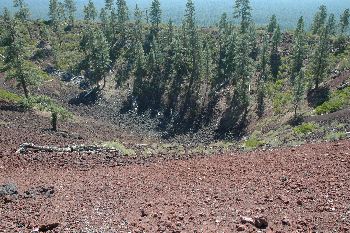 Formed 6,190 years ago, Lava Butte is the result of magma reaching the surface and throwing cinders and ash high into the air. Falling back to earth, the material forms a "cinder cone." A surprise is hidden until you look over the edge of the cone. This is a view down into the bowl formed by the cinders being thrown skyward. Also visible from Lava Butte is the Lava Butte Flow. At some point in the eruption, liquid lava broke through the side of the cone and spread over nine-miles of the landscape. A few interesting facts about Lava Butte are: the Lava Butte Flow contains 380,000,000 cubic yards of rock which is enough material to pave a 160,000-mile two-lane road; if you compare the volume of the Lava Butte to Lava Butte Flow it would be 10% cinder to 90% fluid magma; and, the red and black cinders found on Lava Butte are the result of some cinders being "recycled" or landing back in the crater and hurled up again, exposing the black cinders to more oxygen and turning them red. There are more interesting tidbits to be learned at the Lava Butte Visitor Center.
Formed 6,190 years ago, Lava Butte is the result of magma reaching the surface and throwing cinders and ash high into the air. Falling back to earth, the material forms a "cinder cone." A surprise is hidden until you look over the edge of the cone. This is a view down into the bowl formed by the cinders being thrown skyward. Also visible from Lava Butte is the Lava Butte Flow. At some point in the eruption, liquid lava broke through the side of the cone and spread over nine-miles of the landscape. A few interesting facts about Lava Butte are: the Lava Butte Flow contains 380,000,000 cubic yards of rock which is enough material to pave a 160,000-mile two-lane road; if you compare the volume of the Lava Butte to Lava Butte Flow it would be 10% cinder to 90% fluid magma; and, the red and black cinders found on Lava Butte are the result of some cinders being "recycled" or landing back in the crater and hurled up again, exposing the black cinders to more oxygen and turning them red. There are more interesting tidbits to be learned at the Lava Butte Visitor Center.
|
 Formed 6,190 years ago, Lava Butte is the result of magma reaching the surface and throwing cinders and ash high into the air. Falling back to earth, the material forms a "cinder cone." A surprise is hidden until you look over the edge of the cone. This is a view down into the bowl formed by the cinders being thrown skyward. Also visible from Lava Butte is the Lava Butte Flow. At some point in the eruption, liquid lava broke through the side of the cone and spread over nine-miles of the landscape. A few interesting facts about Lava Butte are: the Lava Butte Flow contains 380,000,000 cubic yards of rock which is enough material to pave a 160,000-mile two-lane road; if you compare the volume of the Lava Butte to Lava Butte Flow it would be 10% cinder to 90% fluid magma; and, the red and black cinders found on Lava Butte are the result of some cinders being "recycled" or landing back in the crater and hurled up again, exposing the black cinders to more oxygen and turning them red. There are more interesting tidbits to be learned at the Lava Butte Visitor Center.
Formed 6,190 years ago, Lava Butte is the result of magma reaching the surface and throwing cinders and ash high into the air. Falling back to earth, the material forms a "cinder cone." A surprise is hidden until you look over the edge of the cone. This is a view down into the bowl formed by the cinders being thrown skyward. Also visible from Lava Butte is the Lava Butte Flow. At some point in the eruption, liquid lava broke through the side of the cone and spread over nine-miles of the landscape. A few interesting facts about Lava Butte are: the Lava Butte Flow contains 380,000,000 cubic yards of rock which is enough material to pave a 160,000-mile two-lane road; if you compare the volume of the Lava Butte to Lava Butte Flow it would be 10% cinder to 90% fluid magma; and, the red and black cinders found on Lava Butte are the result of some cinders being "recycled" or landing back in the crater and hurled up again, exposing the black cinders to more oxygen and turning them red. There are more interesting tidbits to be learned at the Lava Butte Visitor Center.